Energy and Reserve under Distributed Energy Resources Management—Day-Ahead, Hour-Ahead and Real-Time
Abstract
:1. Introduction
1.1. Background, Methodology and Aim
1.2. Literature Review and Specific Contributions
1.3. Paper Organisation
2. Model Features
2.1. First Stage—Day-Ahead Scheduling
2.2. Second Stage—Intraday Scheduling
2.3. Third Stage—Real-Time Scheduling
3. Model Formulation
3.1. Day-Ahead Model
3.2. Intraday Model
3.3. Real-Time Model
4. Case Study
4.1. Case Characterization
4.2. Results
5. Conclusions
Acknowledgments
Author Contributions
Conflicts of Interest
Nomenclature
Parameters
| Elementary period t duration (e.g., 15 min (0.25), 30 min (0.50)) | |
| Grid-to-Vehicle efficiency | |
| Vehicle-to-Grid efficiency | |
| Imaginary part in admittance matrix (S) | |
| Resource cost in period t (m.u./kWh) | |
| Stored energy in the battery of vehicle at the end of period t (kWh) | |
| Energy stored in the battery of vehicle at the beginning of period 1 (kWh) | |
| Energy consumption in the battery during a trip that occurs in period t (kWh) | |
| Real part in admittance matrix (S) | |
| Total number of resources | |
| Maximum apparent power (kVA) | |
| Total number of periods | |
| Set of lines connected to a certain bus | |
| Voltage in polar form (V) | |
| Penalization cost (m.u./kWh) | |
| Series admittance of line that connect two buses (S) | |
| Shunt admittance of line that connect two buses (S) |
Variables
| Voltage angle | |
| Active power (kW) | |
| Reactive power (kVAr) | |
| Relaxation variable for downward reserve (kW) | |
| Relaxation variable for upward reserve (kW) | |
| Voltage magnitude (V) | |
| Binary variable |
Indexes
| Downward reserve service | |
| Power requirement for the AS | |
| Upward reserve service | |
| Battery energy capacity | |
| Minimum stored energy to be guaranteed at the end of period t | |
| Bus | |
| Charge process | |
| Day-ahead stage | |
| Discharge process | |
| Battery degradation | |
| Distributed generation unit | |
| Forecast power of distributed generation unit in period t | |
| Demand response program for loads with continuous regulation | |
| Demand response program for loads with discrete regulation (on/off) | |
| Electric vehicle | |
| Generation curtailment power | |
| Bus i and Bus j | |
| Intraday stage | |
| Load | |
| Periods in the real-time stage | |
| Upper bound limit | |
| Lower bound limit | |
| Non-supplied demand | |
| Real-time stage | |
| Storage unit | |
| Stored energy in the battery of the vehicle for the energy and RD services | |
| Stored energy in the battery of the vehicle for the energy, RU, SP and NS services | |
| External supplier | |
| Line | |
| Total maximum limit for the resources considering the energy, RU, SP and NS services | |
| Total minimum limit for the resources considering the energy and RD services |
References
- Lund, H. Renewable Energy Systems: A Smart Energy Systems Approach to the Choice and Modeling of 100% Renewable Solutions, 2nd ed.; Elsevier: Boston, MA, USA, 2014. [Google Scholar]
- Jones, L. Renewable Energy Integration: Practical Management of Variability, Uncertainty and Flexibility in Power Grids, 1st ed.; Elsevier: Boston, MA, USA, 2014. [Google Scholar]
- Ela, E.; Kirby, B.; Navid, N.; Smith, J.C. Effective ancillary services market designs on high wind power penetration systems. In Proceedings of the 2012 IEEE Power and Energy Society General Meeting, San Diego, CA, USA, 22–26 July 2012; pp. 1–8. [Google Scholar]
- Morais, H.; Pinto, T.; Vale, Z.; Praca, I. Multilevel negotiation in smart grids for VPP management of distributed resources. IEEE Intell. Syst. 2012, 27, 8–16. [Google Scholar] [CrossRef]
- Nosratabadi, S.M.; Hooshmand, R.-A.; Gholipour, E. A comprehensive review on microgrid and virtual power plant concepts employed for distributed energy resources scheduling in power systems. Renew. Sustain. Energy Rev. 2017, 67, 341–363. [Google Scholar] [CrossRef]
- González, P.; Villar, J.; Díaz, C.A.; Campos, F.A. Joint energy and reserve markets: Current implementations and modeling trends. Electr. Power Syst. Res. 2014, 109, 101–111. [Google Scholar] [CrossRef]
- Cochran, J.; Miller, M.; Milligan, M.; Ela, E.G.; Arent, D.; Bloom, A.; Futch, M.; Kiviluoma, J.; Holttinen, H.; Orths, A. Market Evolution: Wholesale Electricity Market Design for 21st Century Power Systems; National Renewable Energy Laboratory: Washington, DC, USA, 2013.
- Soares, T.; Bessa, R.J.; Pinson, P.; Morais, H. Active Distribution Grid Management based on Robust AC Optimal Power Flow. IEEE Trans. Smart Grid 2017, PP, 1. [Google Scholar] [CrossRef]
- Burger, S.; Chaves-Ávila, J.P.; Batlle, C.; Pérez-Arriaga, I.J. The Value of Aggregators in Electricity Systems; MIT Center for Energy and Environment Policy Research: Cambridge, MA, USA, 2016. [Google Scholar]
- Morais, H.; Kádár, P.; Faria, P.; Vale, Z.A.; Khodr, H.M. Optimal scheduling of a renewable micro-grid in an isolated load area using mixed-integer linear programming. Renew. Energy 2010, 35, 151–156. [Google Scholar] [CrossRef]
- Tushar, W.; Chai, B.; Yuen, C.; Smith, D.B.; Wood, K.L.; Yang, Z.; Poor, H.V. Three-Party Energy Management With Distributed Energy Resources in Smart Grid. IEEE Trans. Ind. Electron. 2014, 62, 1–12. [Google Scholar] [CrossRef]
- Iqbal, M.; Azam, M.; Naeem, M.; Khwaja, A.S.; Anpalagan, A. Optimization classification, algorithms and tools for renewable energy: A review. Renew. Sustain. Energy Rev. 2014, 39, 640–654. [Google Scholar] [CrossRef]
- Guerrero-Mestre, V.; de la Nieta, A.A.S.; Contreras, J.; Catalão, J.P.S. Optimal Bidding of a Group of Wind Farms in Day-Ahead Markets Through an External Agent. IEEE Trans. Power Syst. 2016, 31, 2688–2700. [Google Scholar] [CrossRef]
- Haddadian, G.; Khalili, N.; Khodayar, M.; Shahidehpour, M. Optimal scheduling of distributed battery storage for enhancing the security and the economics of electric power systems with emission constraints. Electr. Power Syst. Res. 2015, 124, 152–159. [Google Scholar] [CrossRef]
- Arslan, O.; Karasan, O.E. Cost and emission impacts of virtual power plant formation in plug-in hybrid electric vehicle penetrated networks. Energy 2013, 60, 116–124. [Google Scholar] [CrossRef] [Green Version]
- Sousa, T.; Morais, H.; Castro, R.; Vale, Z. Evaluation of different initial solution algorithms to be used in the heuristics optimization to solve the energy resource scheduling in smart grids. Appl. Soft Comput. 2016, 48, 491–506. [Google Scholar] [CrossRef]
- Delfino, F.; Minciardi, R.; Pampararo, F.; Robba, M. A multilevel approach for the optimal control of distributed energy resources and storage. IEEE Trans. Smart Grid 2014, 5, 2155–2162. [Google Scholar] [CrossRef]
- Song, I.-K.; Jung, W.-W.; Kim, J.-Y.; Yun, S.-Y.; Choi, J.-H.; Ahn, S.-J. Operation Schemes of Smart Distribution Networks With Distributed Energy Resources for Loss Reduction and Service Restoration. IEEE Trans. Smart Grid 2013, 4, 367–374. [Google Scholar] [CrossRef]
- Ghafouri, A.; Milimonfared, J.; Gharehpetian, G.B. Coordinated Control of Distributed Energy Resources and Conventional Power Plants for Frequency Control of Power Systems. IEEE Trans. Smart Grid 2015, 6, 104–114. [Google Scholar] [CrossRef]
- Soares, T.; Pinson, P.; Jensen, T.V.; Morais, H. Optimal Offering Strategies for Wind Power in Energy and Primary Reserve Markets. IEEE Trans. Sustain. Energy 2016, 7, 1036–1045. [Google Scholar] [CrossRef]
- Yang, Y.; Zhai, Q.; Guan, X. An hour-ahead scheduling problem for a system with wind resource. In Proceedings of the 2012 IEEE Power and Energy Society General Meeting, San Diego, CA, USA, 22–26 July 2012; pp. 1–8. [Google Scholar]
- Ghadikolaei, H.M.; Tajik, E.; Aghaei, J.; Charwand, M. Integrated day-ahead and hour-ahead operation model of discos in retail electricity markets considering DGs and CO2 emission penalty cost. Appl. Energy 2012, 95, 174–185. [Google Scholar] [CrossRef]
- Liu, Y.; Nair, N.K.C. A Two-Stage Stochastic Dynamic Economic Dispatch Model Considering Wind Uncertainty. IEEE Trans. Sustain. Energy 2016, 7, 819–829. [Google Scholar] [CrossRef]
- Adinolfi, F.; Burt, G.M.; Crolla, P.; Agostino, F.D.; Saviozzi, M.; Silvestro, F. Distributed Energy Resources Management in a Low-Voltage Test Facility. IEEE Trans. Ind. Electron. 2015, 62, 2593–2603. [Google Scholar] [CrossRef]
- Silva, M.; Morais, H.; Vale, Z. An integrated approach for distributed energy resource short-term scheduling in smart grids considering realistic power system simulation. Energy Convers. Manag. 2012, 64, 273–288. [Google Scholar] [CrossRef]
- Salinas, S.; Li, M.; Li, P.; Fu, Y. Dynamic Energy Management for the Smart Grid with Distributed Energy Resources. IEEE Trans. Smart Grid 2013, 4, 2139–2151. [Google Scholar] [CrossRef]
- Rahbar, K.; Chai, C.C.; Zhang, R. Real-time energy management for cooperative microgrids with renewable energy integration. In Proceedings of the 2014 IEEE International Conference on Smart Grid Communications (SmartGridComm), Venice, Italy, 3–6 November 2014; pp. 25–30. [Google Scholar]
- Rahimiyan, M.; Baringo, L. Strategic Bidding for a Virtual Power Plant in the Day-Ahead and Real-Time Markets: A Price-Taker Robust Optimization Approach. IEEE Trans. Power Syst. 2016, 31, 2676–2687. [Google Scholar] [CrossRef]
- Li, H.; Li, F.; Xu, Y.; Rizy, D.T.; Adhikari, S. Autonomous and adaptive voltage control using multiple distributed energy resources. IEEE Trans. Power Syst. 2013, 28, 718–730. [Google Scholar] [CrossRef]
- Shahnia, F.; Chandrasena, R.P.S.; Rajakaruna, S.; Ghosh, A. Primary control level of parallel distributed energy resources converters in system of multiple interconnected autonomous microgrids within self-healing networks. Gener. Transm. Distrib. IET 2014, 8, 203–222. [Google Scholar] [CrossRef]
- Kulmala, A.; Repo, S.; Järventausta, P. Coordinated Voltage Control in Distribution Networks Including Several Distributed Energy Resources. IEEE Trans. Smart Grid 2014, 5, 1–11. [Google Scholar] [CrossRef]
- Silva, M.; Morais, H.; Sousa, T.; Vale, Z. Energy resources management in three distinct time horizons considering a large variation in wind power. In Proceedings of the European Wind Energy Conference & Exhibition 2013, Vienna, Austria, 4–7 February 2013. [Google Scholar]
- Zakariazadeh, A.; Jadid, S.; Siano, P. Economic-environmental energy and reserve scheduling of smart distribution systems: A multiobjective mathematical programming approach. Energy Convers. Manag. 2014, 78, 151–164. [Google Scholar] [CrossRef]
- Mohan, V.; Singh, J.G.; Ongsakul, W. An efficient two stage stochastic optimal energy and reserve management in a microgrid. Appl. Energy 2015, 160, 28–38. [Google Scholar] [CrossRef]
- Ferreira, J.; Monteiro, V.; Afonso, J. Vehicle-to-Anything Application (V2Anything App) for Electric Vehicles. IEEE Trans. Ind. Inform. 2013, 10, 1927–1937. [Google Scholar] [CrossRef]
- Soares, J.; Canizes, B.; Lobo, C.; Vale, Z.; Morais, H. Electric vehicle scenario simulator tool for smart grid operators. Energies 2012, 5, 1881–1899. [Google Scholar] [CrossRef]
- Vecchietti, A.; Grossmann, I.; Raman, R.; Kalvelagen, E. DICOPT Solver; Carnegie Mellon University, and GAMS Development Corporation: Pittsburgh, PA, USA, 2008. [Google Scholar]
- Rosenthal, R. GAMS—A User’s Guide; GAMS Development Corporation: Washington, DC, USA, 2008. [Google Scholar]
- Peterson, S.B.; Whitacre, J.F.; Apt, J. The economics of using plug-in hybrid electric vehicle battery packs for grid storage. J. Power Sources 2010, 195, 2377–2384. [Google Scholar] [CrossRef]
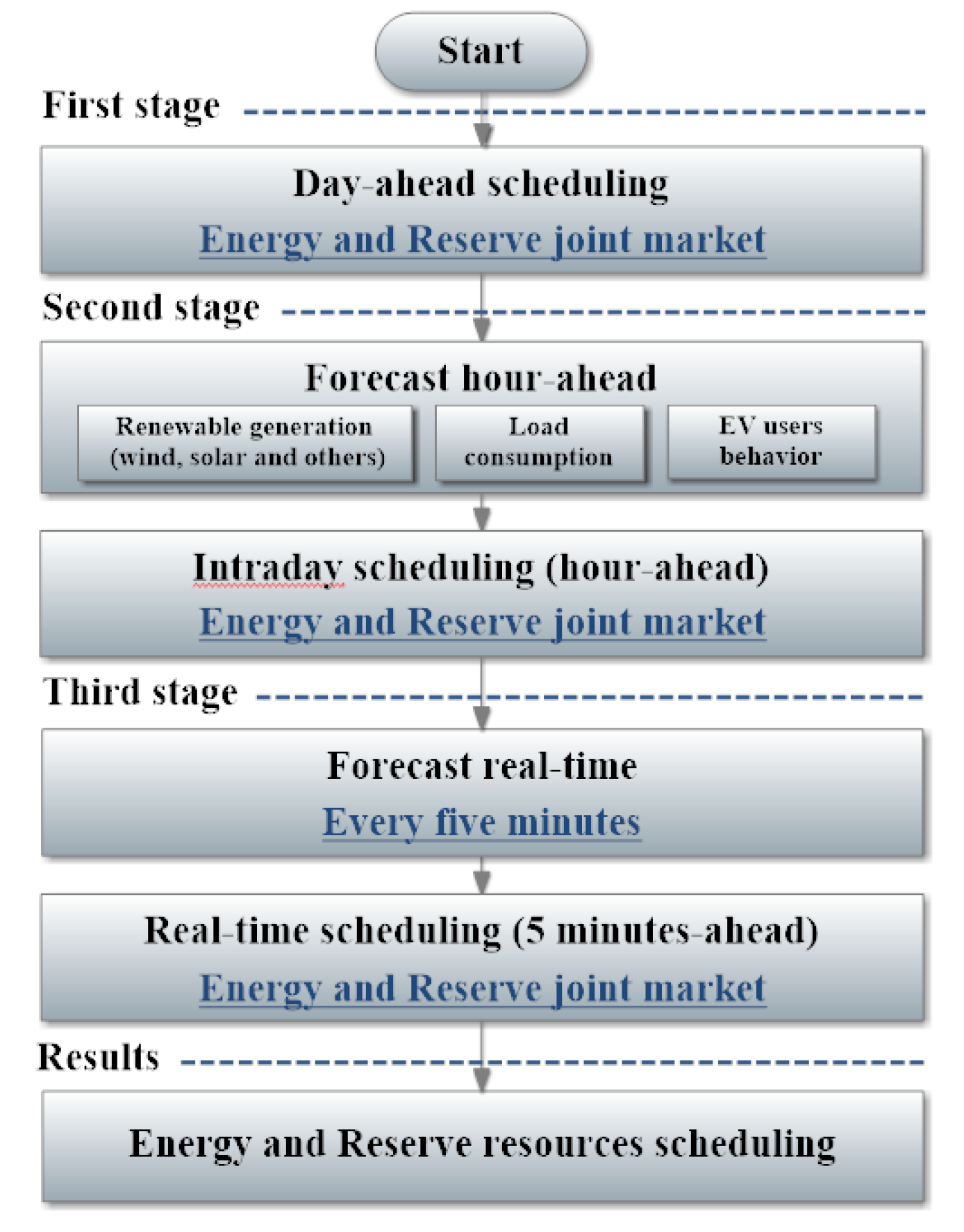
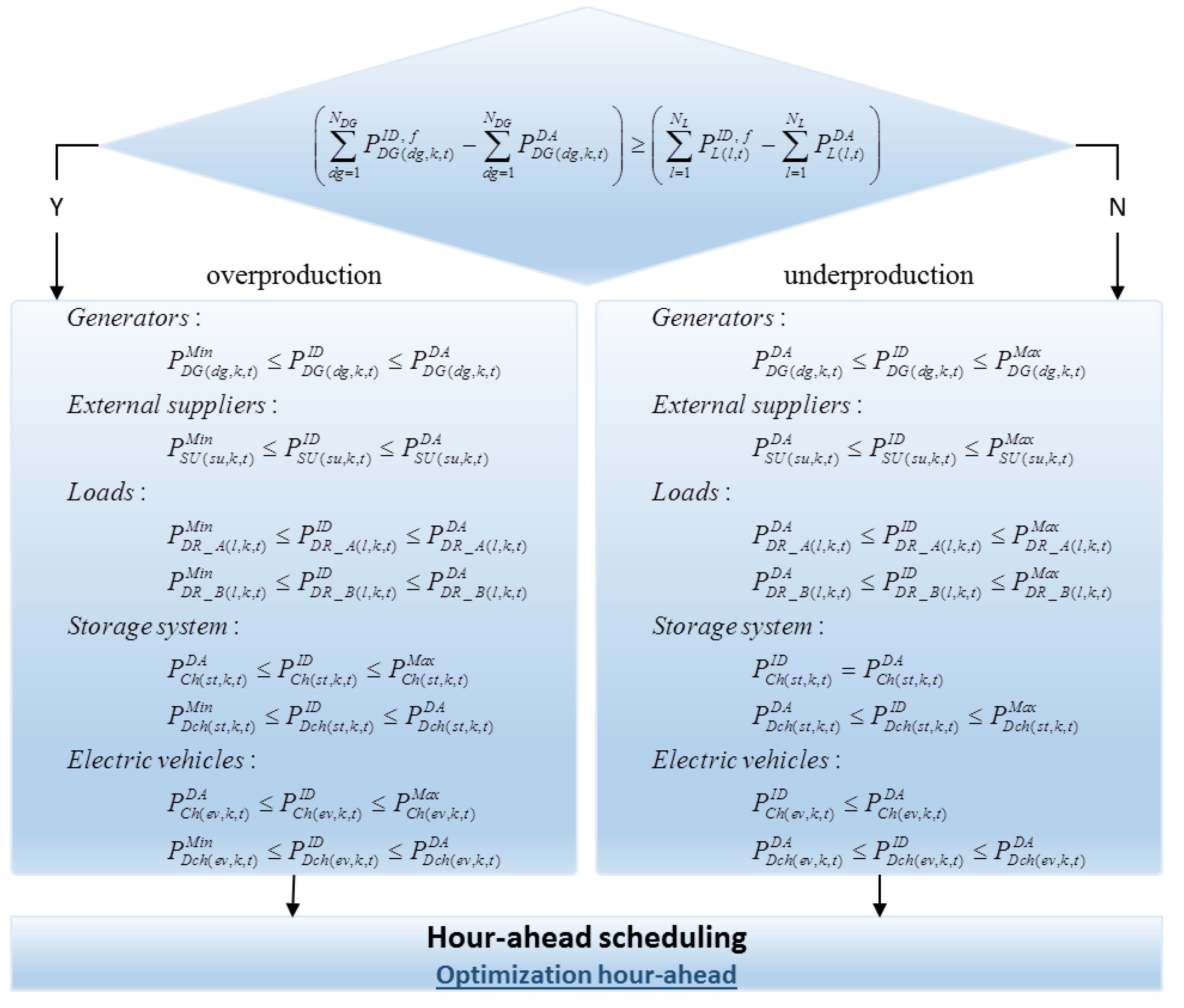
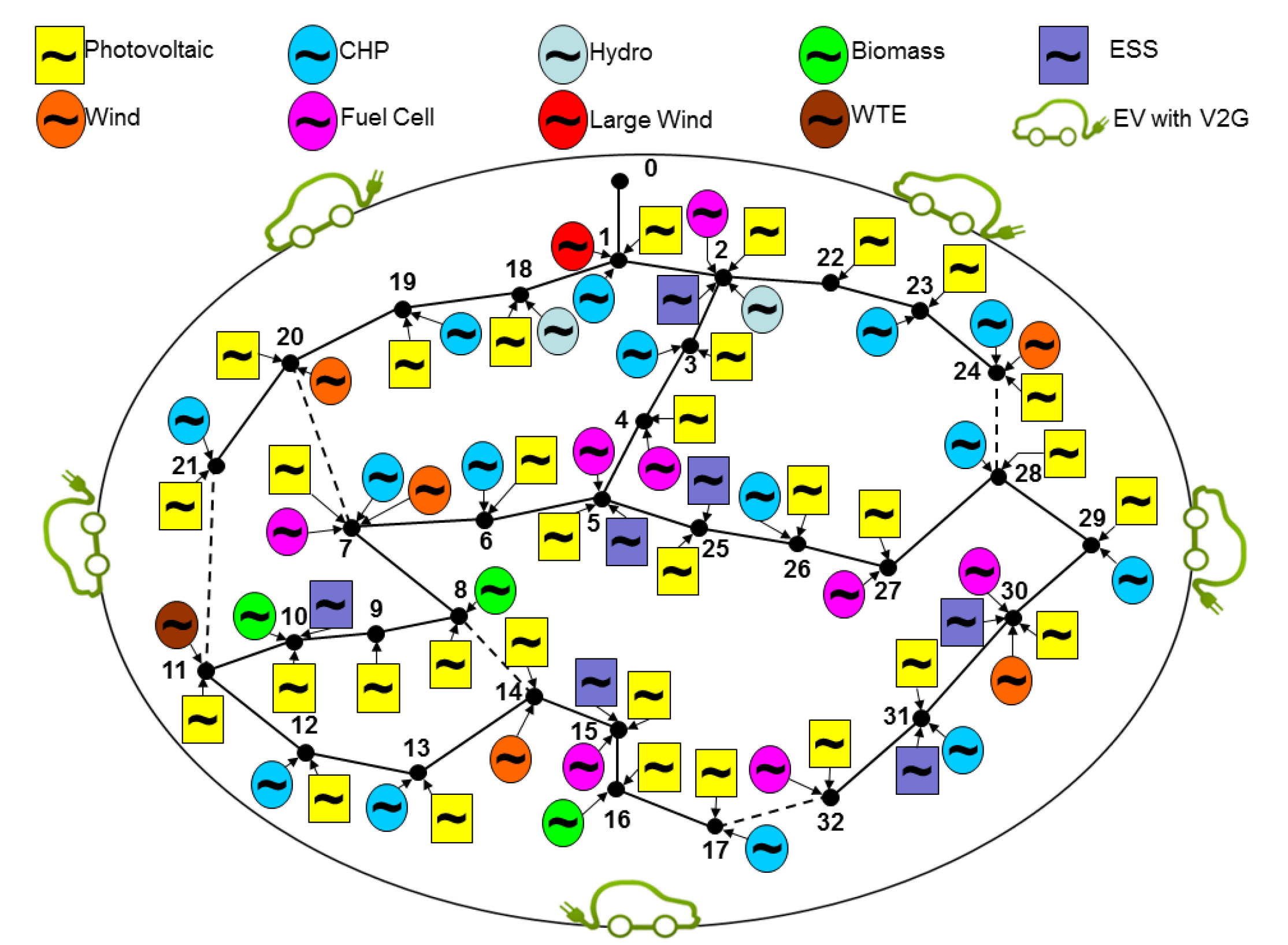
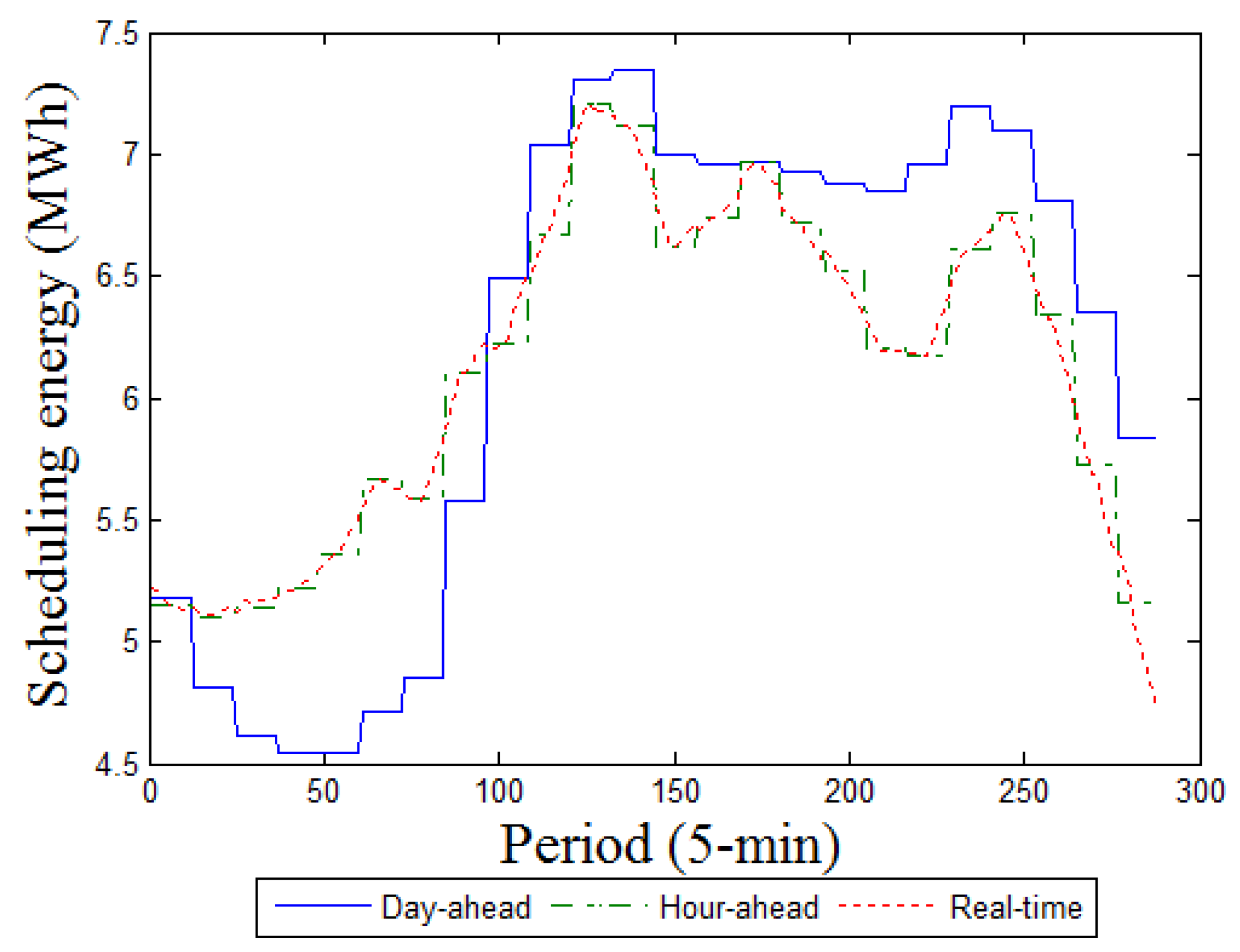

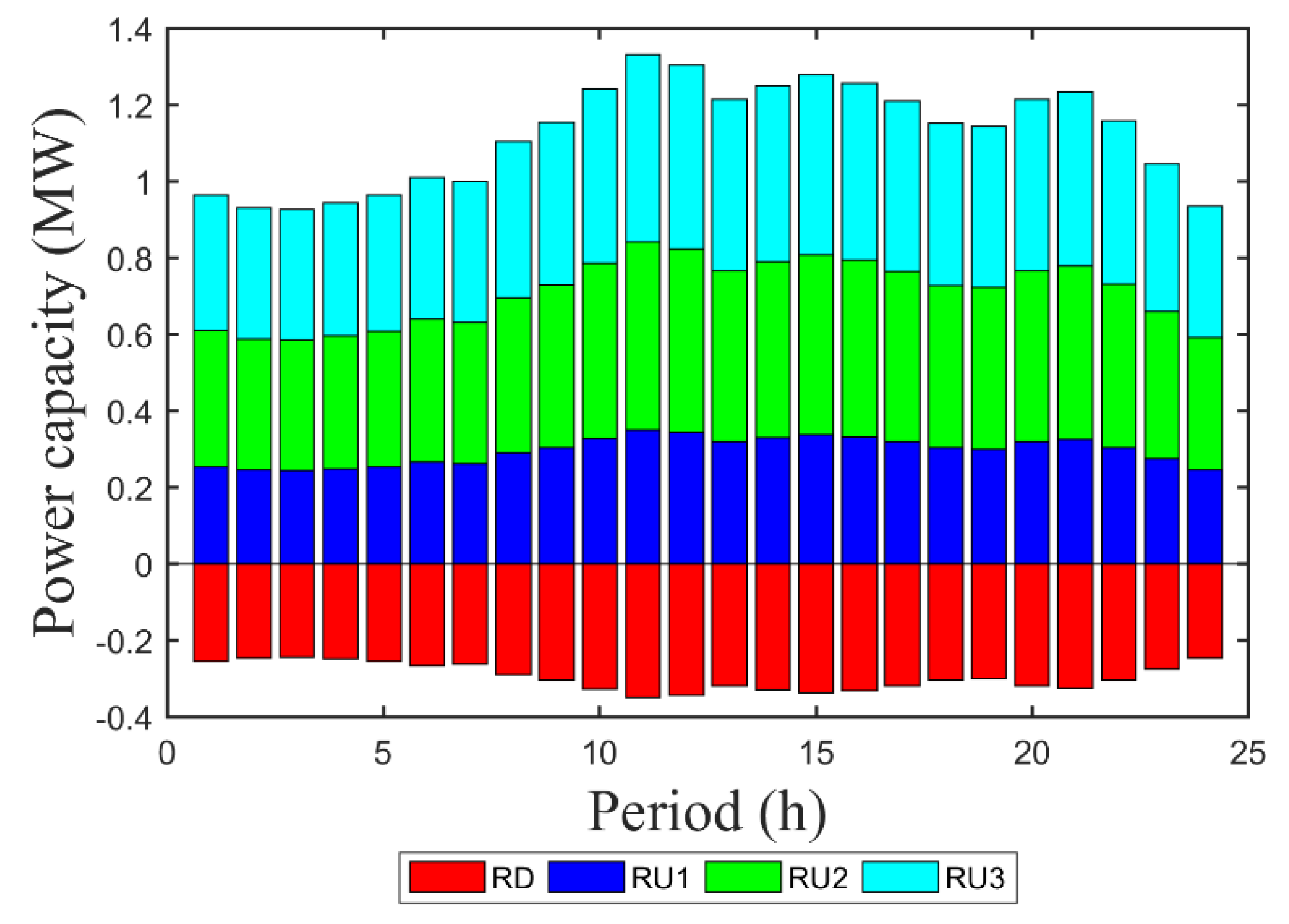
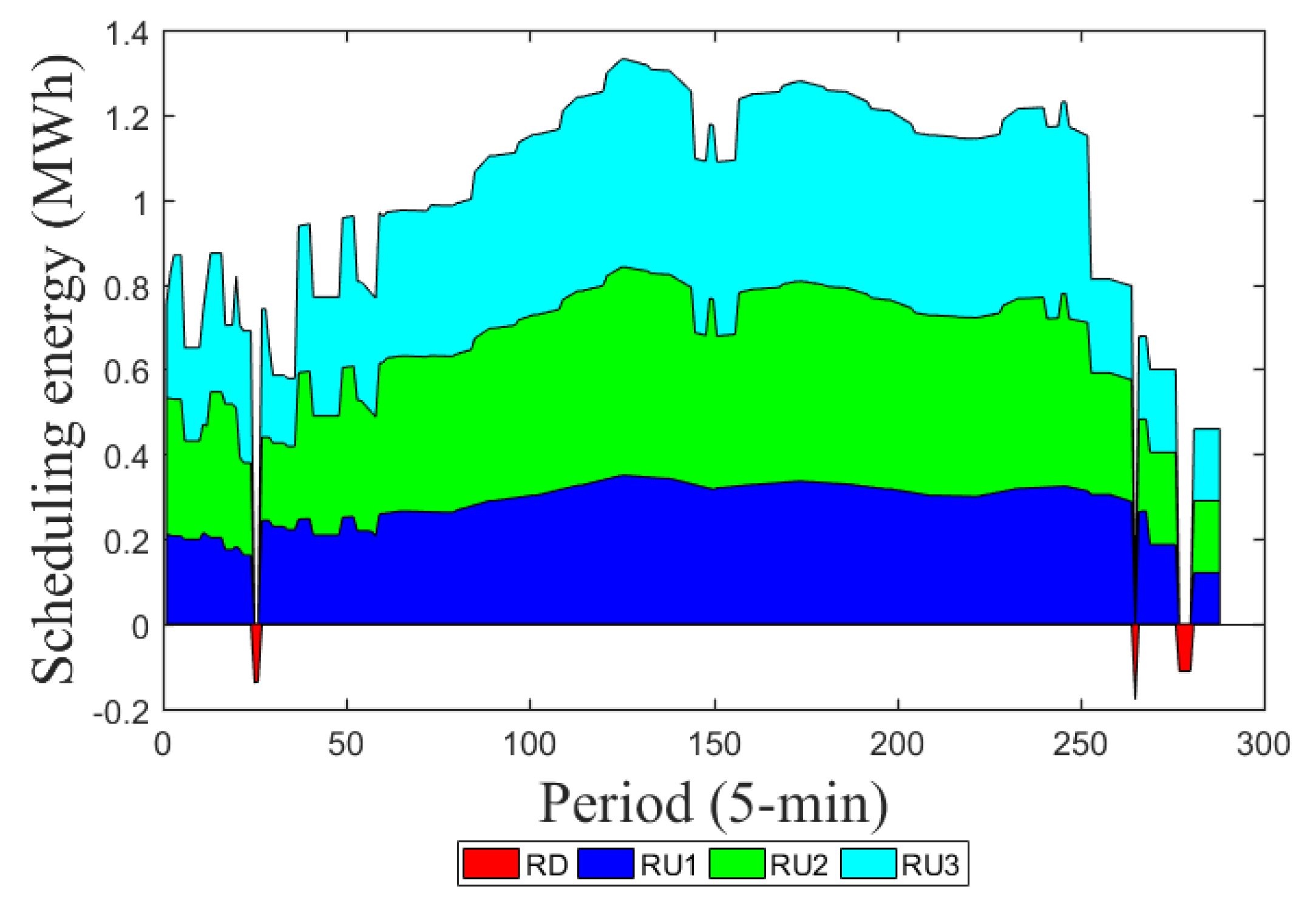
| Energy Resources | Availability (kW) Min–Max | Prices (m.u./kWh) | |
|---|---|---|---|
| Biomass | 0–375 | 0.09 | |
| CHP | 0–1150 | 0.06 | |
| Fuel cell | 0–210 | 0.09 | |
| Small hydro | 0–70 | 0.07 | |
| Photovoltaic | 0–837 | 0.20 | |
| Waste-to-energy | 0–10 | 0.10 | |
| Small wind | 182–891 | 0.15 | |
| Large wind | 2000–5000 | 0.07 | |
| External supplier | 0–6200 | 0.06–0.15 | |
| Storage | Charge | 0–1050 | 0.09–0.16 |
| Discharge | 0–700 | 0.11–0.18 | |
| Electric vehicle | Charge | 0–6305 | 0.09–0.16 |
| Discharge | 0–6616 | 0.20 | |
| Demand response | Red | 0–1731 | 0.150–0.160 |
| Cut | 0–831 | 0.160 | |
| Consumers demand | 4251–7451 | 0.14 | |
| Energy Resources | Power (kW) | Price (m.u./kWh) | ||||
|---|---|---|---|---|---|---|
| [RD, RU_1] | [RU_2, RU_3] | [RD, RU_1] | RU_2 | RU_3 | ||
| Biomass | 0–18.8 | 0–26.3 | 0.099 | 0.108 | 0.116 | |
| CHP | 0–57.5 | 0–80.5 | 0.066 | 0.072 | 0.078 | |
| Fuel cell | 0–10.5 | 0–14.7 | 0.099 | 0.108 | 0.116 | |
| Small hydro | 0–3.5 | 0–4.9 | 0.077 | 0.084 | 0.090 | |
| Photovoltaic | 0–41.9 | 0–58.6 | 0.220 | 0.240 | 0.260 | |
| Waste-to-energy | 0–0.5 | 0–0.7 | 0.110 | 0.120 | 0.130 | |
| Small wind | 9.1–44.6 | 12.7–62.4 | 0.165 | 0.180 | 0.194 | |
| Large wind | 100–250 | 140–350 | 0.077 | 0.084 | 0.090 | |
| External supplier | 0–310 | 0–434 | 0.115 | 0.126 | 0.136 | |
| Storage | Charge | 0–1050 | 0.145 | 0.158 | 0.172 | |
| Discharge | 0–700 | 0.168 | 0.183 | 0.198 | ||
| Demand response | Red | 0–173.1 | 0–121.2 | 0.168 | 0.183 | 0.198 |
| Cut | 0–41.6 | 0–58.2 | 0.176 | 0.192 | 0.208 | |
| Energy Resources | Day-Ahead (MW) | Hour-Ahead (MW) | |||||||||
|---|---|---|---|---|---|---|---|---|---|---|---|
| Energy | RD | RU_1 | RU_2 | RU_3 | Energy | RD | RU_1 | RU_2 | RU_3 | ||
| Biomass | 0.304 | 0.019 | 0.019 | 0.026 | 0.026 | 0.338 | 0.019 | 0 | 0.011 | 0.026 | |
| CHP | 0.932 | 0.058 | 0.058 | 0.081 | 0.081 | 0.951 | 0.058 | 0.038 | 0.080 | 0.081 | |
| Fuel cell | 0.077 | 0.011 | 0.002 | 0.001 | 0.006 | 0.210 | 0.011 | 0 | 0 | 0 | |
| Small hydro | 0.057 | 0.004 | 0.004 | 0.005 | 0.005 | 0.057 | 0.004 | 0.004 | 0.005 | 0.005 | |
| Photovoltaic | 0.180 | 0 | 0 | 0 | 0 | 0.144 | 0 | 0 | 0 | 0 | |
| Waste-to-energy | 0.008 | 0.001 | 0.001 | 0.001 | 0.001 | 0.009 | 0.001 | 0 | 0 | 0.001 | |
| Small wind | 0.182 | 0 | 0 | 0 | 0 | 0.146 | 0 | 0 | 0 | 0 | |
| Large wind | 4.500 | 0 | 0 | 0 | 0 | 1.350 | 0 | 0 | 0 | 0 | |
| External supplier | 2.450 | 0.246 | 0.190 | 0.358 | 0.267 | 3.534 | 0.236 | 0.193 | 0.266 | 0.266 | |
| Storage | Charge | 0 | 0 | 0 | 0 | 0 | 0 | 0 | 0 | 0 | 0 |
| Electric vehicles (EV) | Discharge | 0 | 0 | 0 | 0 | 0 | 0 | 0 | 0 | 0 | 0 |
| Charge | 1.771 | - | - | - | - | 1.771 | - | - | - | - | |
| Discharge | 0 | - | - | - | - | 0 | - | - | - | - | |
| Demand response (DR) | Red | 0.123 | 0 | 0.064 | 0 | 0.086 | 1.331 | 0 | 0.092 | 0.096 | 0.079 |
| Cut | 0 | 0 | 0 | 0 | 0 | 0.368 | 0 | 0 | 0 | 0 | |
| Consumers demand | 6.740 | 0 | 0 | 0 | 0 | 6.537 | 0 | 0 | 0 | 0 | |
| Power losses | 0.3018 | 0.131 | |||||||||
| AS requirement | - | 0.337 | 0.337 | 0.472 | 0.472 | - | 0.327 | 0.327 | 0.458 | 0.458 | |
| Energy Resources | Real-Time (MW) | |||||
|---|---|---|---|---|---|---|
| Energy | RD | RU_1 | RU_2 | RU_3 | ||
| Biomass | 0.338 | 0 | 0 | 0.011 | 0.026 | |
| CHP | 0.951 | 0 | 0.014 | 0.078 | 0.078 | |
| Fuel cell | 0.210 | 0 | 0 | 0 | 0 | |
| Small hydro | 0.057 | 0 | 0.004 | 0.005 | 0.005 | |
| Photovoltaic | 0.229 | 0 | 0 | 0 | 0 | |
| Waste-to-energy | 0.009 | 0 | 0 | 0 | 0.001 | |
| Small wind | 0.147 | 0 | 0 | 0 | 0 | |
| Large wind | 1.566 | 0 | 0 | 0 | 0 | |
| External supplier | 3.478 | 0 | 0.178 | 0.266 | 0.266 | |
| Storage | Charge | 0.042 | 0 | 0.042 | 0 | 0 |
| Discharge | 0 | 0 | 0 | 0 | 0 | |
| EV | Charge | 1.771 | - | - | - | - |
| Discharge | 0 | - | - | - | - | |
| DR | Red | 1.354 | 0 | 0.092 | 0.092 | 0.079 |
| Cut | 0.187 | 0 | 0 | 0 | 0 | |
| Consumers demand | 6.577 | 0 | 0 | 0 | 0 | |
| Power losses | 0.137 | |||||
| AS requirement | - | 0 | 0.329 | 0.460 | 0.460 | |
© 2017 by the authors. Licensee MDPI, Basel, Switzerland. This article is an open access article distributed under the terms and conditions of the Creative Commons Attribution (CC BY) license (http://creativecommons.org/licenses/by/4.0/).
Share and Cite
Soares, T.; Silva, M.; Sousa, T.; Morais, H.; Vale, Z. Energy and Reserve under Distributed Energy Resources Management—Day-Ahead, Hour-Ahead and Real-Time. Energies 2017, 10, 1778. https://doi.org/10.3390/en10111778
Soares T, Silva M, Sousa T, Morais H, Vale Z. Energy and Reserve under Distributed Energy Resources Management—Day-Ahead, Hour-Ahead and Real-Time. Energies. 2017; 10(11):1778. https://doi.org/10.3390/en10111778
Chicago/Turabian StyleSoares, Tiago, Marco Silva, Tiago Sousa, Hugo Morais, and Zita Vale. 2017. "Energy and Reserve under Distributed Energy Resources Management—Day-Ahead, Hour-Ahead and Real-Time" Energies 10, no. 11: 1778. https://doi.org/10.3390/en10111778







